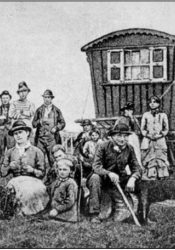Romani (Gypsy) Migration
[Historical, Chapter 3, pp. 140] The history of the Romani, or Gypsy, people was shrouded in mystery until about the 18th century as they did not have a strong tradition of written or oral history. Stefan Valyi, a Hungarian theology student, began to study the Romani language to learn more about Gypsy history and culture, which sparked further scholarship on the Romani people. While the reason for the migration of the Romani people from India to Europe is unknown, it is highly likely that they migrated to Europe to escape the invasion go Afghan general Mahmud of Ghazni in the early 11th century. The Romani people would eventually split up and migrate in smaller groups, some going to Northern Africa and Greece while others continued migrating to Europe. By the early 1500s, the Romani people had a fairly sizable population in Sweden, England, and Scotland. The term Gypsy originated from “Egyptian” which the European population perceived them to be because of their dark complexion. The term Gypsy is considered offensive by the Romani people as this word was often used as a racial slur. The Romani population in England would have been about one generation established by the time Orlando encounters them directly after their transformation from a man to a woman. While the Gypsy people and Orlando may not have gotten along super well (pg. 151), Orlando’s interaction with a people group removed from the strict confines of English society was an important connection to make as Orlando explores their unconventional and fluid concepts of gender. (260 word count)
“Migrations of the Romani People.” National Geographic, https://media.nationalgeographic.org/assets/file/romani_MIG.pdf. Accessed March 13 2023.
Woolf, Virginia. “Chapter 3.” Orlando: A Biography, Mariner Books, Boston, 2022, pp. 140-143.

